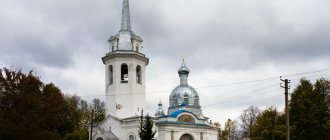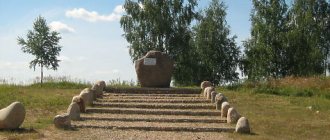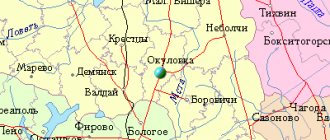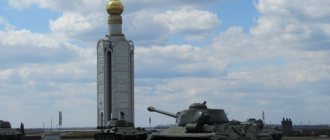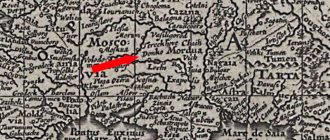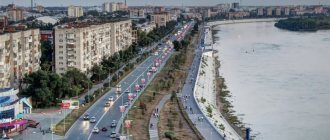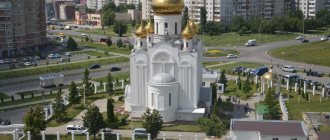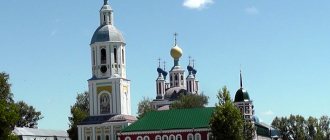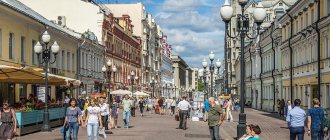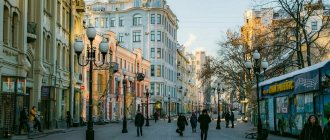The most interesting thing about traveling is the surprises and surprises that come with it. Our summer trips around the area ended with a visit to the town of Mglina and the ancient village of Novaya Romanovka - places where I had never been before. It turned out that in the city itself and in its surroundings there is a lot that I would like to share with the readers of my blog.
Story
Mglin is one of the ancient Russian cities, founded, according to the Ipatiev Chronicle, under the original name Zara in the middle of the 12th century - in 1154. However, later, from 1359, the city was mentioned in Lithuanian sources and documents as a possession of the Grand Duchy of Lithuania with the epic name Mglin.
The name of the city is traditionally associated with the once gloomy, misty forests that surrounded it. Other researchers believe that the name came from the water mills that once surrounded the city (in Ukrainian “mlyn” means mill). According to one version, in the 12th century, on the southern outskirts of the modern city, on the territory of the settlement, there was the city of Zarub, completely destroyed by the Mongol-Tatars. Mglin begins to appear in the lists of Russian cities during the years of Lithuanian rule in the second half of the 14th century, and in 1501 - after the expulsion of the Lithuanians.
At the beginning of the 17th century, the city came under the rule of the Polish-Lithuanian Commonwealth. In 1648, with the beginning of the liberation war of the Ukrainian people, Mglin became the military-administrative center of the Mglin hundred of the Starodub regiment. In 1663, the Poles tried to recapture the city, but were defeated by Russian troops in the Battle of Mglin. In 1708, the troops of the Swedish king Charles XII passed through the vicinity of Mglin.
The small town was liked by influential people in Russia. For several years after the fall of Hetman Mazepa, the favorite of Peter I, A.D. Menshikov, considered it his possession.
In 1781, with the abolition of the centenary division, Mglin (it then had about two thousand inhabitants) became a district town of the Novgorod-Seversky governorship, and from 1802 - in the Chernigov province. For a long time it remained a small administrative and trading town. In memory of “...the deliverance of Mglin from enemy invasion and devastation...” the townspeople built the Cathedral of the Assumption of Our Lady (1830).
By 1861, its population had quadrupled. Three brick factories, two tallow factories and a tannery appeared here. They were very small and their products, which did not exceed 10 thousand rubles in value, were sold locally. However, they did not last long; at the beginning of the 20th century they were no longer there, but two oil mills appeared, producing 19 thousand pounds of hemp oil. Trade in hemp, oil, and livestock fell into decline. The decline in the city's business activity is explained by the competition of Pochep, which received better conditions for development with the construction of the Bryansk-Gomel railway. Only local crafts flourished in Mglin. A noticeable outflow of population began.
It was during this period of decline that a resident of the Mglinsky district, A. K. Tolstoy, to the poem by A. S. Pushkin:
There is a city in Russia called Luga, St. Petersburg District. This little town wouldn’t be any worse if it weren’t for my Novorzhev in the world.
added the following lines:
There is another city, It is called Mglin, Nice to Jews and cows, It is worth Lugi with Novorzhev.
After the fall of the Provisional Government in 1917, the power of the Central Rada of Ukraine was extended to the city, then the government of Hetman Pavlo Skoropadsky. In 1919 it was annexed to the Gomel province of the RSFSR. Since 1926, the city has been part of the Bryansk province.
The Soviet government made an attempt to stop the decline. Several enterprises for processing agricultural products and a sawmill were built in the city. After the Great Patriotic War, a starch and syrup factory, a butter factory, a brick factory, a clothing factory, and an industrial plant were re-established. The population again reached 8 thousand people.
The modern city has its own coat of arms, known since the 18th century: “There are three golden towers connected in a green field, the middle one with a gate.” Architectural monuments have been preserved in the buildings of the historical city (the city of Mglin is one of the 115 ancient Russian cities in Russia).
An ancient manor in Novaya Romanovka
But the most striking impression of the trip was a visit to the ancient and poorly preserved Dunin-Borkovsky estate, located in the village of Novaya RomanOvka.
The village itself was founded in 1694 by centurion Ivan Romanovsky, hence the emphasis - not RomAnovka, as we thought when we read the name on the sign, but RomanOvka! Like many old estates, the estate passed from hand to hand, experiencing periods of ups and downs.
Artist V.L. Borovikovsky
Some important events in this estate and its surroundings are associated with the life and work of the famous Russian artist Vladimir Lukich Borovikovsky (1757–1825), one of the first portrait painters in Russia.
The artist was born in Mirgorod. His father, Luka Borovik, belonged to the local Cossack elders, owned a house and two small plots of land. Following tradition, four of his sons served in the Mirgorod regiment, but Vladimir retired with the rank of lieutenant and devoted himself to painting.
The father, who painted icons for rural churches, taught icon painting to his children, and the Borovikov dynasty became famous in the local art association. The Kiev Museum of Ukrainian Art and the Russian Museum contain icons painted by the young painter.
A happy accident allowed Vladimir to distinguish himself in front of the empress. He painted two allegorical paintings for one of the “travel palaces”, which Catherine II liked, and she invited the artist to St. Petersburg to study at the Academy of Arts. His mentor and teacher was first the Russian portrait artist D.G. Levitsky, and then the Austrian painter who worked at the court, I.D. Lampi.
Borovikovsky quickly became a popular and fashionable portrait painter, his paintings are kept in the largest art galleries in Russia and Ukraine, in them we can see the faces of his famous contemporaries - Empress Catherine II, Emperor Paul I, their courtiers, noble people of that time.
Particularly lyrical and memorable were his portraits of women and children - Maria Lopukhina, the Gagarin sisters, etc. In his portraits, the artist almost always found a place for the Little Russian landscape that was dear to his heart. A deeply religious man, Borovikovsky also painted icons.
Church of the Intercession
At the beginning of the 19th century, the famous artist painted an iconostasis with 26 icons for the stone Church of the Intercession under construction, all of them were done in oil on large wooden boards.
To this day, five icons by Borovikovsky from the Church of the Intercession in Novaya Romanovka have survived - “The Savior”, “The Virgin and Child”, “Archangel Michael” are in the State Tretyakov Gallery, another one - “Archangel Gabriel” - in Alma-Ata, in the State Kazakh Gallery, and the icon “Queen Alexandra and Archdeacon Stefan” is in the Bryansk Regional Art Museum (data from the “Code ...”).
It is not clear whether Vladimir Lukich himself visited Novaya Romanovka, I did not find exact information, and on the unpreserved main icon of the Church of the Intercession, as sources testify, there was an inscription: “In this temple, icons were painted by the Imperial Academy of Arts by adviser Vladimir Lukich Borovikovsky in S.P. "Burg 1815"
The Church of the Intercession itself had a very interesting architectural design. Built in the style of late classicism, it had a cruciform composition, which gave it simplicity and harmony. Plastered inside and out, with noble proportions, the church was visible from afar.
But, like many other religious buildings, the church, although, fortunately, was not destroyed, remained desolate for many decades. Only recently did local residents take up the task of restoring it. The old walls still demonstrate an enviable fortress, so that, in time, it will delight our contemporaries, as it once pleased their ancestors. But the iconostasis by Borovikovsky will no longer be there...
Main house
The ruins of the beautiful old Dunin-Borkowski estate are now suitable only for filming a horror film about vampires. But until relatively recently, it was almost completely intact, having avoided destruction and becoming a rural school for quite a long time, as evidenced by the remains of panels preserved on the walls. Probably, after the construction of a new school in the early 70s, this old estate began to truly collapse and is now a sad sight!
One can only guess what rooms were there before! But there was a ballroom, and state living rooms, and bedrooms, and offices. All this was filled with beautiful furniture, decorated with paintings, possibly works of famous artists, and simply filled with the life of the family, its guests and the spirit of the times!
Education, culture and sports
Educational institutions are represented by two secondary schools: Mglinskaya secondary school No. 1 and Mglinskaya secondary school No. 2, Mglinskaya boarding school, Mglinskaya technical school of agricultural technologies (former vocational school-37) and a branch of the Bryansk Institute of Management and Business, formed on the basis of Mglinskaya secondary school No. 2.
The city has the Mglinsky Museum of Local Lore, located in the Mglinsky park.
The local football club "Zarty" plays in the second division of the Bryansk region championship.
The Mglin volleyball team is the champion of the Bryansk region.
There is a youth sports school in the city, as well as art and music schools.
In 2013, a new sports and recreation complex “Dream” was opened, with a swimming pool and gyms.
Who were the inhabitants of ancient Zarty?
These places were inhabited mainly by tribes
of northerners and Radimichi .
The forests surrounding the area were practically impassable, there were no land roads, so the settlements were partly protected by their inaccessibility. The only connecting thread with other lands was the Sudynka River, connecting with the larger Iput (= Slavic “this is the way”). One of the probable locations of the ancient settlement of Zartyya is a ledge between the Sudynka and its tributary Molotovka - this place is extremely convenient for defense.
Radimichi - reconstruction of appearance.
The way of life of the Radimichi is hunting, fishing, hunting
- was determined precisely by their residence in forests abounding in game and furs.
Later, the tribe of northerners brought the technology of farming on forest burning to the region
. According to the Great Russian Encyclopedia, the East Slavic tribe of the Radimichi paid tribute to the Khazar Kaganate until the 9th century, then around 885 they came under the protectorate of the Prophetic Oleg, as part of whose troops the Radimichi took part in the campaign against Byzantium in 907. In 984\985. There was some discord, in connection with which Vladimir Svyatoslavich sent an army to the Radimichi under the command of the governor Wolf Tail - in the battle on the river. The Sandy Radimichi were defeated. Subsequently, their territories became part of the Smolensk and Chernigov principalities.
The history of the Northern tribe is generally similar to the history of the Radimichi. From about 730's found themselves subject to the Khazar Khaganate, to which they paid tribute, then began to pay “light tribute” to Prince Oleg instead of Khazaria. Until the beginning of the 11th century. retain a certain autonomy, in particular they appear as a separate force in references to the army of Mstislav of Vladimir the Brave (Prince of Chernigov). From the middle of the 11th century. completely included in Ancient Rus'.
Map of the settlement of the ancient Slavs
In the vicinity of the Mglinsky district, numerous mounds have survived to this day ,
poured by the ancient northerners and Radimichi along the entire Iput River, the name of which in Old Slavic means “this is the way.” They were preserved near the village of Degtyarevki in the Starchichi tract of the Verkhne-Iputskoye forestry and near the village of Lugovets in the Sosenki tract of the Southern forestry.
Here one finds such typical Radimichi decorations as seven-rayed temple ring pendants, spiral temple rings, pendants in the form of a bull's head, moon, cross, dogs, spoons and bells, as well as sickles and weapons. The culture of the northerners is also characterized by radial temporal rings. And perhaps it does not make sense to strongly divide them into two separate groups, since they, in principle, were close neighbors and often lived in the same territories.
Traditional Radimichi jewelry. Photo source
1–4, 6–21 - from the mounds of Novozybkovsky and Surazhsky districts of the Bryansk province (excavations by P. M. Eremenko
);
5 — reconstruction of a headdress based on materials from a mound near the village. Yudich (according to M.A. Saburova
) 1–4, 7–75, 17, 19–21 - non-ferrous metal; 6, 16, 18 - bronze and glass
An interesting fact is that the Mglinsky football club today is called “Zarty” in memory of this ancient city.
External links [edit]
- Murder of the Jews of Mglin during World War II, on the Yad Vashem website.
| vteAdministrative divisions in the Bryansk region | ||
| Administrative center: Bryansk • Village. | ||
| Districts |
| |
| Cities and towns |
| |
| Urban settlements |
| |
